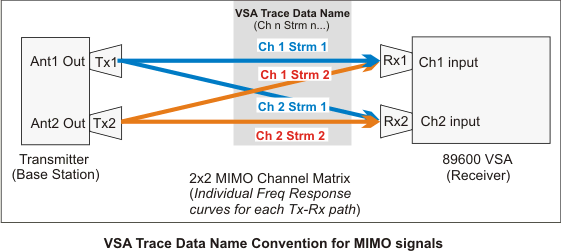Ch Frequency Response (802.11n/ac/ax/be/bn)
is the channel frequency response for a spatial stream received on a particular measurement channel.
is computed as the reciprocal of the FFT Fast Fourier Transform: A mathematical operation performed on a time-domain signal to yield the individual spectral components that constitute the signal. See Spectrum. of the Equalizer Impulse Response. The Channel Frequency Response provides one complex value for each subcarrier plus an interpolated value for the middle unused null subcarrier. The equalizer frequency response is normally estimated from the Channel Estimation Sequence (HT high throughput-LTF Long Training field or VHT very high throughput (VHT) physical (PHY) layer protocol data unit (PPDU):A PPDU transmitted using the TXVECTOR FORMAT parameter equal to VHT.-LTF) portion of the OFDM Orthogonal Frequency Division Multiplexing: OFDM employs multiple overlapping radio frequency carriers, each operating at a carefully chosen frequency that is Orthogonal to the others, to produce a transmission scheme that supports higher bit rates due to parallel channel operation. OFDM is an alternative tranmission scheme to DSSS and FHSS. preamble. However, when the Equalization Training parameter is set to , the equalizer frequency response is estimated using both the Channel Estimation Sequence and the payload Data. See the Equalizer Training topic for more information.
The frequency response data results are similar to the Digital Demod Ch Frequency Response trace data. The differences are:
- Digital Demodulation computes this by comparing the and data, while 802.11n/ac demodulation computes it from the preamble/data of the burst.
- Digital Demodulation typically uses a running average to average multiple scans when computing the equalizer frequency response. 802.11n/ac/ax/be/bn demodulation does not average, but computes a new equalizer response for each burst.
- The equalization filter is inherent to 802.11n/ac/ax/be/bn Demodulation and cannot be enabled/disabled like in Digital Demodulation.
Understanding the Trace Data Results
There is a channel frequency response trace data result for each input channel and spatial stream (ChX StrmX) path for the MIMO Multiple Input, Multiple Output: A physical layer (PHY) configuration in which both transmitter and receiver use multiple antennas. system.
For example, a 2x2 MIMO system, which is composed of 2 channels and 2 spatial streams, has four channel frequency response trace data results, one for each channel/spatial-stream path: Ch1 Strm1, Ch1 Strm2, Ch2 Strm1, and Ch2 Strm 2 (where "Ch" is the measurement channel and "Strm" is the spatial stream). The following graphic shows the VSA MIMO trace data naming convention for multi-channel NxN MIMO system.

For Nt transmit channels, the VSA supports demodulating the single stream case (Nss = 1) and the Nss = Nt stream case, even though the standard allows all variations from 1 to Nt streams.
The following table shows how the number of frequency response measurements expand as the number of channel inputs and spatial streams increase:
| Number of Channels | Channel Frequency Response Measurements | |
| 1 | Channel 1 | Stream 1 |
| 2 |
Channel 1 |
Stream 1 Stream 2 |
|
Channel 2 |
Stream 1 Stream 2 |
|
| 3 |
Channel 1 |
Stream 1 Stream 2 Stream 3 |
|
Channel 2 |
Stream 1 Stream 2 Stream 3 |
|
|
Channel 3 |
Stream 1 Stream 2 Stream 3 |
|
| ... | ||
See Also
